Raf Vandersmissen, Sinfrared, and Thomas Zimmermann, TIB Infrared Solutions
A mid-wave infrared camera visualizes methane gas leaking from a drilling platform.
Methane is a greenhouse gas that is significantly more damaging than carbon dioxide. When it leaks uncontrolled from industrial plants, it can easily escape into the atmosphere. This is seen primarily as an economic loss, but it also contributes to the destruction of the environment. Sensitive high-resolution mid-wave infrared (MWIR) cameras can accurately detect such emissions without placing a direct-measurement gas-detection system in the danger zone.
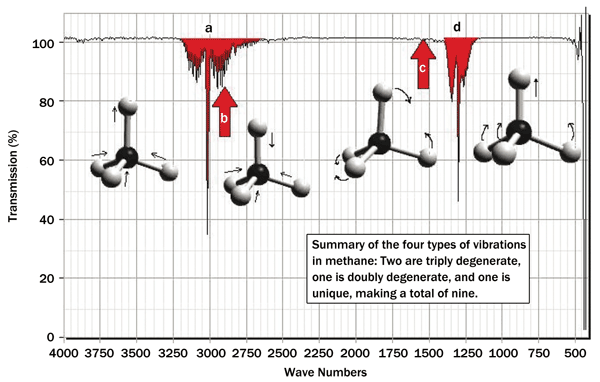
Figure 1. The transmission spectrum of methane (CH4) shows a strong attenuation between 3.3 and 3.6 µm and at a wavelength of 7.6 µm.
Gas leaking from a drilling platform
A March 2012 incident on the Elgin Wellhead gas drilling platform in the North Sea focused public attention on the risk connected with offshore mining of oil and gas.1 Elgin Wellhead (Figure 2) is one of more than 400 rigs in the North Sea, and it is a significant part of the exploration of the Elgin/Franklin field.
As was discovered later, a gas leak had formed at the cover of well G4, which had been installed a few months earlier. A sequence and combination of several individual events never seen before had led to a kind of stress corrosion, which occurred only on G4. The incident was caused mainly by a chalk layer about 1000 m above the gas reservoir.
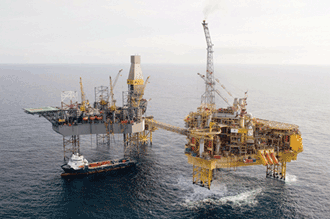
Figure 2. The Elgin Wellhead drilling platform is one of more than 400 rigs located in the North Sea.
As a consequence, a severe methane gas leak developed in this area. Production was halted, and the drilling platform crew was evacuated, because the exact position of the leak and the amount of gas emitted could not be determined. Additionally, it was not known whether the flame on top of the platform was still burning. Because of the danger of a possible explosion, a three-mile no-go area surrounding the rig was declared, and another 4000-ft exclusion zone was established in the airspace above the rig.
However, these precautions complicated the initial efforts to close the leak, as appropriate countermeasures could be attempted only after the gas concentration at the accident location had fallen below a critical value. Since these exposure limits did not permit taking a direct gas probe and subsequent gas analysis, an alternative method had to be consid
ered to determine the methane content in the environment from afar. It was found in an absorption measurement of the infrared light in hydrocarbons.
IR absorption of hydrocarbons
Hydrocarbons are chemical compounds that consist only of carbon and hydrogen. Their simplest configuration is methane, a colorless and odorless combustible gas having the notation CH4. Its molecular model is shown in Figure 1.2 Its four C-H bonds are pointing toward the corners of a tetrahedron.
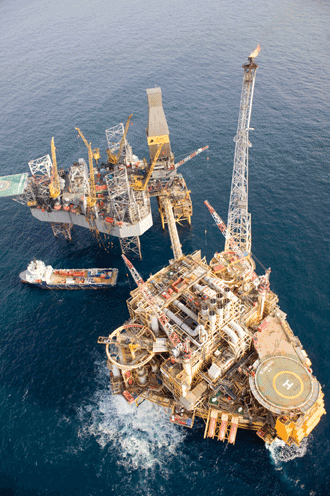
The Elgin Platform.
This molecule structure exhibits four atomic oscillation modes, differentiated by either generating a temporal dipole moment – modes (a) and (d) – or not – modes (b) and (c). Only the first two can be excited by an external infrared radiation. They have a transmission spectrum shown in Figure 1 for the wave number area reaching from 4000/cm (which relates to a wavelength of 2.5 µm) to 500/cm (20 µm).
A wave number of 3019/cm (3.3-µm wavelength) relates to the absorption band of the antisymmetrical valence oscillation (a), whereas the deformation oscillation (d), whose movement is similar to the unfolding of an umbrella, causes a strong attenuation around a wavelength of 7.6 µm (at a wave number of 1306/cm). Both areas are suited for remote methane gas sniffing, with the stronger attenuation value favoring the use of the MWIR band around
3.3 µm. Additionally, it would be advantageous if the image components in the visible spectrum were captured as well for a spatial assignment.
MWIR camera with extended spectrum area
In the case of the gas leak at the Elgin Wellhead drilling platform, the measurement task was defined primarily as visualizing the gas components (methane, butane and carbon dioxide), as well as the characteristics of their spreading in the form of a gas cloud close to the sea surface and in the atmosphere. An additional goal was determining the activity of the flame on the platform. These investigations were carried out by TIB Infrared Solutions, in cooperation with the laboratory for environmental measurements at the University of Applied Sciences Düsseldorf. The Onca MWIR camera from Xenics, with expanded spectral coverage, was used for this purpose (Figure 3).
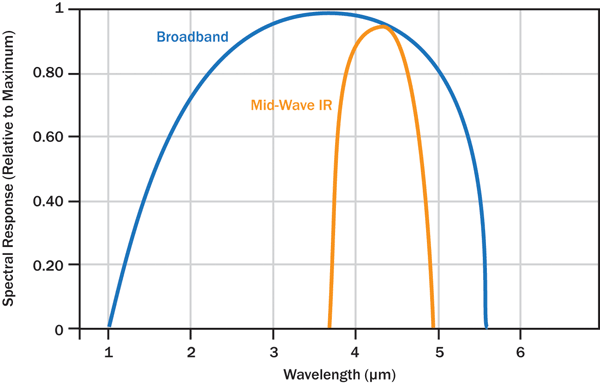 Figure 3. The extended spectral area of an MWIR camera simplifies the spatial assignment of gas plumes to visible objects.
Figure 3. The extended spectral area of an MWIR camera simplifies the spatial assignment of gas plumes to visible objects.
The Onca camera family is equipped with a Stirling-cooled detector array in mercury-cadmium-telluride (MCT) or InSb detector technology. It is especially well suited for research and development tasks with high-speed image capture or IR spectroscopy. The camera operates in the extended MWIR area from 3.7 to
4.8 µm, which can be further expanded to cover the 1- to 5-µm wavelength area. This camera layout increases its all-weather and night-vision suitability and is of specific interest for spectroscopy applications.
Using the TrueThermal technique, this camera system offers an accuracy of ±2 °C (or ±2 percent, whichever is largest). This is made possible by a new, stable method called NUC (nonuniformity correction), which eliminates the need for frequent adjustments. Four optional radiometric
temperature ranges – −20 to 120 °C, 50 to 400 °C, 300 to 1200 °C and 1000 to 2000 °C – cover a wide variety of applications.
The camera platform is optimized for autonomous operation and also in combination with a PC. Among other valuable features, it offers a mode for real-time image correction. The area-array sensor is available with a standard resolution of 320 × 256 pixels (InSb) or 384 × 288 pixels (MCT), or in a high-resolution version featuring 640 × 512 pixels. Both versions offer the sensitivity specification NETD (noise-equivalent temperature difference) of less than 20 mK.
The camera output delivers image
data that is 14 bits wide at various frame rates. Two speeds are available: 30-Hz standard video with 640 × 512 pixels, and 60-Hz with 320 × 256 (InSb) or 384 × 288 (MCT) pixels. Additionally, 100 Hz is available at high resolution, as well as an extremely fast version with 460 Hz and 320 × 256-pixel resolution. Reading out partial images will further increase the frame rate, which is especially useful for process-control applications at high frame rates. The camera functions can be tailored to the specific application, with the parameters stored in the camera’s nonvolatile memory.
To adapt the camera to a specific measurement procedure, five filter-position options have been incorporated. Unlike most filter holders, which accept just one 25-mm filter of 1-mm thickness, the holders on the Onca’s filter wheel are much deeper, and each position can hold several filters up to a total thickness of 3 mm for spectral measurements.
The camera is user-programmable to offer individual filter positions and integration times for each exposure. However, because of the additional time needed for changing the filter and readjusting the operational parameters, the maximum frame rate mentioned above cannot always be reached.
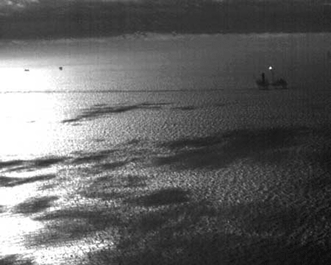
Figure 4. From above, methane plumes look like dark clouds in the MWIR spectrum.
This flexibility, together with a stable thermal calibration across various integration times, enables a new operational mode called SuperFraming, which delivers thermal images of a high dynamic range in real time derived from images specifically exposed to users’ specifications. Using this special operational mode, the user can locate hot and cold spots in an image for fast process-monitoring sequences.
Camera control and image capture are laid out for more than 100 images per second. Compatibility with GigE Vision and Camera Link simplifies the integration in user systems. For application development support, an API is available, as well as sample codes in C++, Visual Basic and Delphi; LabView drivers; and a comprehensive DLL library.
Remote gas measurement
The solution to the complex measurement task of visualizing gas components leaking from the well close to the drilling platform and spreading as a plume over the sea surface into the atmosphere was deploying the high-resolution (640 × 512 pixels) MWIR camera with an extended wavelength area from 1 to 5 µm, operating at a frame rate of 100 Hz.?Using this type of camera broke new ground for the researchers. The exclusion zone forced the IR investigation to be done from a large distance. This was an operational condition, for which there were no previously established procedures or proven results.
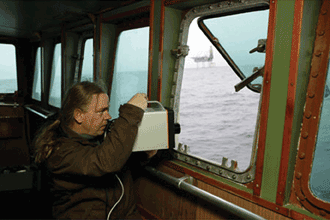
Figure 5. The high-resolution, high-sensitivity MWIR camera Onca performs a checkup from sea level.
The methane clouds can be detected even under these difficult measurement conditions; this is shown in an image taken from a plane flying over the scene (Figure 4). In the upper right is the drilling platform, with flame burning. The shadows visible in the foreground and in the center are caused by the methane gas plumes. They are illuminated by light reflections on the sea surface, and they absorb the midrange IR radiation at around 3.3 µm.
This image-capture process requires two filters, one for the bandpass around 3.3 µm, for methane absorption, and a second in the short-wave IR to make physical objects such as the drilling platform visible. By analyzing this dual-band image, certain gas concentrations can be assigned to fixed objects. This makes the interpretation of such images much easier.
To detect gases whose transmission spectrum is different from that of methane, other filters or filter combinations are available. The results can be presented in different colors to distinguish among several gases in one image.
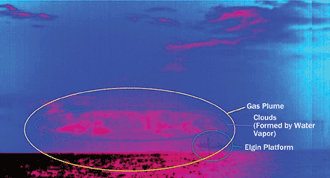
Figure 6. False-color representation of MWIR images enables the detection of the gas plume behind clouds formed by water vapor.
Taking aerial pictures of the gas-leak scene was not the only investigative method for determining the scope of the disturbance at the drilling platform. Examinations were also carried out from aboard a ship (Figure 5). They proved that the water molecules and drops suspended in the atmosphere above the sea level are causing a strong attenuation of the MWIR radiation. Despite this effect, the gas components located behind this water vapor can be determined because naturally occurring clouds appear fully saturated, whereas the gas plume appears more like a fog.
Deploying the MWIR camera allowed a quick check of the working conditions so that a repair crew could be sent to the site. On May 15, the leak was plugged by discharging heavy mud into the well. After final closure with five cement plugs in October 2012, the drilling platform went back to operation in March 2013.
Meet the authors
Raf Vandersmissen is CEO at sInfraRed, a subsidiary of Xenics, in Belgium; email: [email protected]. Thomas Zimmermann is owner of TIB Infrared Solutions in Niederzier, Germany; email: [email protected].
References
1. www.elgin.total.com/elgin.
2. http://www.physik.uni-regensburg.de/for schung/wegscheider/gebhardt_files/skrip ten/Molekuelabsorption.Heimbach.pdf.